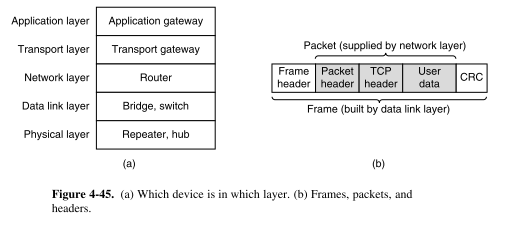4
Which layer of network stack do access points operate? (My question also leads me to wonder https://superuser.com/questions/902820/which-device-can-create-a-new-network).
My question arises when reading Tanebaum's Computer Network:
So far in this book, we have looked at a variety of ways to get frames and packets from one computer to another. We have mentioned repeaters, hubs, bridges, switches, routers, and gateways. All of these devices are in common use, but they all differ in subtle and not-so-subtle ways. Since there are so many of them, it is probably worth taking a look at them together to see what the similarities and differences are.
The key to understanding these devices is to realize that they operate in different layers, as illustrated in Fig. 4-45(a). The layer matters because different devices use different pieces of information to decide how to switch. In a typical scenario, the user generates some data to be sent to a remote machine. Those data are passed to the transport layer, which then adds a header (for example, a TCP header) and passes the resulting unit down to the network layer. The network layer adds its own header to form a network layer packet (e.g., an IP packet). In Fig. 4-45(b), we see the IP packet shaded in gray. Then the packet goes to the data link layer, which adds its own header and checksum (CRC) and gives the re- sulting frame to the physical layer for transmission, for example, over a LAN.

About access points:
802.11 networks are made up of clients, such as laptops and mobile phones, and infrastructure called APs (access points) that is installed in buildings. Access points are sometimes called base stations. The access points connect to the wired network, and all communication between clients goes through an access point.

Also from http://en.wikipedia.org/wiki/Wireless_access_point
In computer networking, a wireless Access Point (AP) is a device that allows wireless devices to connect to a wired network using Wi-Fi, or related standards. The AP usually connects to a router (via a wired network) as a standalone device, but it can also be an integral component of the router itself.
Another source says
In a sense, it's very much like a hub in that it pays no attention to the data that crosses it - it simply sends everything that it receives on a wired connection to the wireless transmitter and everything that it receives wirelessly is sent to the wired connection.
Thanks.
Thanks. WHy doesn't a AP operate just in layer 1 but in 2? A link it says "In a sense, it's very much like a hub in that it pays no attention to the data that crosses it - it simply sends everything that it receives on a wired connection to the wireless transmitter and everything that it receives wirelessly is sent to the wired connection." The book says hub operates in layer 1.
– Tim – 2015-04-17T15:50:47.520I believe layer 1 being the physical layer basically has to do with signals and bits...without any sophisticated intelligent system/software. That is the main difference between the layer 1 hub, and L2 bridge. L2 devices have inbuilt intelligent software such as CAM tables which kind of performs some automation. – Immanuel – 2015-04-17T15:55:16.943
@Tim the AP operates in both Layers 1 (physical transmission of the radio waves) and 2. If it were just Layer 1, imagine how the client (wireless NIC) would encapsulate a packet. What destination would it address its frame to? Layer 2 handles this data-link layer addressing so that it knows to send to the MAC address of the AP as a next-hop instead of simply spewing out noisy broadcast transmissions. – armani – 2015-04-17T17:34:26.713
@Immanuel: Thanks. What makes a router create a new network, while a switch or access point can't? – Tim – 2015-04-17T23:52:58.817
@Tim, Its just difference in technology and functional requirements. A basic purpose for routers is to stop broadcasts; giving you the liberty of whatever you want to do with that external link. (eg create your own network, apply restrictions (ACL), change the network addressing pattern, allow or deny network and/or Internet access, and many other customizable options... OTOH, switches transmits to all ports whatever comes in from an external link without the ability of customizing the external link. You either allow or deny it across selected ports. Although most switches now integrate VLANS. – Immanuel – 2015-04-18T16:04:18.403
As an article (http://blogs.aerohive.com/blog/the-wireless-lan-architecture-blog-3/enterprise-wireless-networking) states, pure wireless access points are mixed L1/L2 devices: L1 hub on wireless side and L2 bridge on wired side.
– Paul – 2015-05-29T14:50:02.333